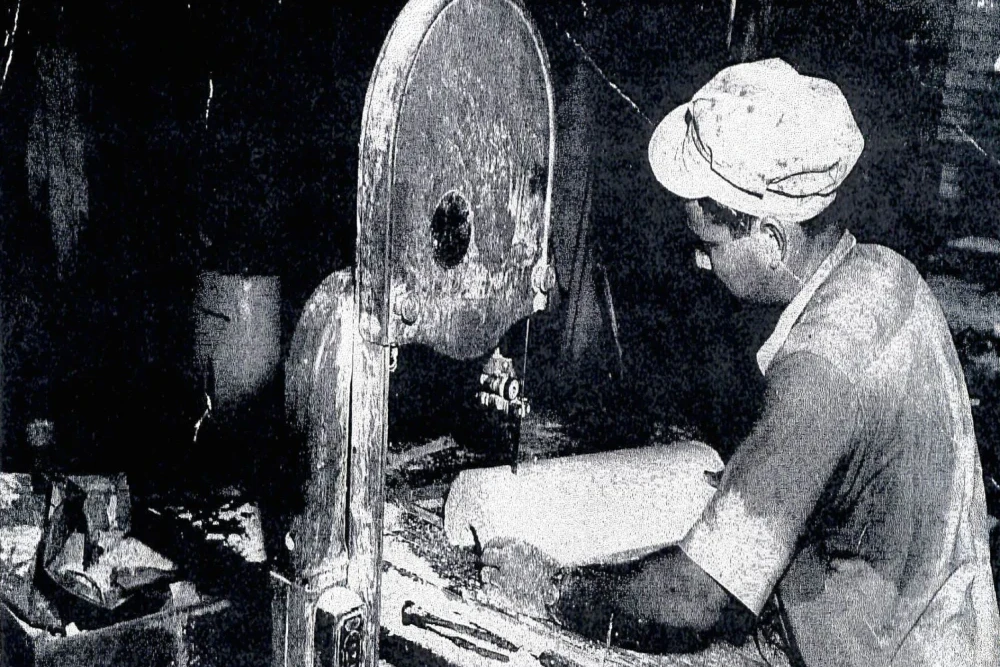Home › Asbestos Job Sites › Paper Mills
Asbestos Exposure in Louisiana Paper Mills
From the beginning of the 20th century, asbestos-containing products were widely used in paper mills. The mills’ equipment was often lined with asbestos insulation. Paper mill workers installed, repaired, maintained, operated, and worked around this equipment daily. When the materials and products containing asbestos were disturbed, microscopic fibers were released into the air and inhaled or ingested by workers, often leading to serious diseases later in life.
Last Updated:
- October 20, 2025
Which Louisiana Paper Mills Used Asbestos?
Due to its abundance of forested land and easy transport via river and sea access, Louisiana became prominent in the papermaking industry. By 1912, the state led the entire country in timber production, and almost half of its terrain was covered by forests. The papermaking industry employed the toxic mineral asbestos in numerous ways right from the start because of its heat resistance, durability, and affordability. The following job sites are known to have used asbestos in their paper production over the years:
View 17 Locations:
- Bogalusa Paper Mill in Bogalusa, LA
- Boise Cascade Paper Mill in DeRidder, LA
- Brown Container Paper Mill in Monroe, LA
- Calcasieu Paper Mill in Elizabeth, LA
- Calkraft Paper Mill in Port Hudson, LA
- Gaylord-Crown Zellerbach Paper Mill in Bogalusa, LA
- Georgia Pacific Paper Mill in Port Hudson, LA
- International Paper Mill in Mansfield, LA
- Pineville Kraft Paper Mill in Pineville, LA
- Smurfit-Stone Container-Continental Can Paper Mill in Hodge, LA
- Southern Kraft Paper Mill in West Monroe, LA
- Temple Inland-Gaylord Bag-Graphic Packaging-Olin Kraft-Brown-Manville Forest Products-Riverwood Paper Mill in West Monroe, LA
- Tembec (Crown) Paper Mill in St. Francisville, LA
- Valentine Pulp & Paper Mill in Lockport, LA
- West Monroe Paper Mill in West Monroe, LA
- Weyerhaeuser Paper Mill in Zwolle, LA
- Willamette-Mead Paper Mill in Campti, LA
How Paper Mills Workers Were Exposed to Asbestos
Paper mills had gigantic drying and pressing machines that compressed the wood pulp under extreme pressure at high temperatures. These machines utilized asbestos felt as an integral component of the drying process.
A large release of asbestos dust in paper mills occurred when workers had to replace the felt once it deteriorated. The caked-on felt, which had been under immense pressure for many weeks as the paper was compressed between the rollers often 24 hours a day, usually had to be chiseled and pried off in bits and pieces, releasing large amounts of deadly asbestos fibers into the air all around the paper mill workers.
Questions About Mesothelioma?
Many chemical plant workers are uncertain about what steps to take after receiving a mesothelioma diagnosis.
Asbestos Products Used by Paper Mills Workers
Due to its heat-resistant properties, many products used during the papermaking process were insulated, lined, and wrapped with asbestos because these products worked at high pressure and temperatures. Some of the most common products and equipment in paper mills that contained asbestos include the following:
- Giant vats
- Pipes
- Turbines
- Boilers
- Steam pipes
- Drying and pressing machines
Did You Know?
From the 1930s through the 1980s, the giant rollers through which the pulp sheets passed were almost always lined with asbestos felt, which could withstand the intense pressure and heat without deteriorating nearly as quickly as other materials.
Tradespeople at Risk of Asbestos Exposure at Paper Mills

Various types of tradespeople all worked around asbestos-containing products at paper mills. These trades didn’t have to utilize the products directly to have been exposed to asbestos. They could have been exposed by working near insulators who worked hands-on with asbestos-containing insulation.
Countless tradespeople and union workers faced asbestos exposure at paper mills through direct or indirect contact, including the following:
At-Risk Family Members of Paper Mills Workers
Paper mill workers’ family members are also at risk of asbestos exposure, as the workers may have carried asbestos fibers home with them on their clothing, skin and in their trucks and cars. If an exposed father left a paper mill where he worked without showering or changing, then hugged his children or spouse when he got home, those family members would then face exposure. In addition, family members who laundered clothing covered with asbestos fibers could have been exposed.
A District Fire Chief’s Story
"He did not know anything about asbestos on his clothes."
My dad worked in the industrial field his whole career. He worked in paper mills and in plants. He would bring home asbestos on his work clothes. It was a secondary exposure to me as I was young growing up.
Was Enough Done to Protect Paper Mill Workers in Louisiana?
Hardly anything was done to protect Louisiana paper mill workers from asbestos in the 20th century before any regulations were imposed to restrict the mineral’s use. The manufacturers of deadly asbestos products have known since the 1930s that their goods could cause diseases like asbestosis, lung cancer, and mesothelioma but concealed the risks, exposing millions of innocent workers to the carcinogen every day. Paper mill owners and product manufacturers put profits over workers’ health.
Compensation for Paper Mill Workers in Louisiana
Paper mill workers diagnosed with mesothelioma or another asbestos-related disease after workplace exposure may have a couple of options for seeking compensation.
1) Mesothelioma Lawsuits: They may file a lawsuit against the manufacturers of the asbestos products they were exposed to.
2) Asbestos Trust Funds: They may also be eligible to claim compensation from asbestos trusts, which set aside a combined $30 billion for victims.
Did You Know?
Your mesothelioma claim may be settled in less than a year without filing a lawsuit or going to court, but strict deadlines limit the time you have to file your claim.
Mesothelioma Settlements and Verdicts for Paper Mill Workers
The compensation range for mesothelioma and lung cancer patients is $500,000 to $10 million in settlements, and may be higher for verdicts. Results may vary.
Our sponsor, Baron & Budd, P.C., has recovered millions of dollars in compensation for Louisiana paper mill workers exposed to asbestos-containing products and materials on the job and later diagnosed with an asbestos-related disease. Some of their most significant awards for paper mill workers include the following:
$4.4 Million for a Paper Mill X-Ray Technologist
Our sponsor recovered more than $4 million for an X-ray technologist diagnosed with mesothelioma and his family. The X-ray tech was exposed to asbestos fibers through his work for mobile testing laboratories at numerous industrial sites, including paper mills. Though he lost his battle with mesothelioma after a four-year fight, the Louisiana mesothelioma lawyers at Baron & Budd P.C. continued fighting against the companies responsible for his illness and secured a substantial settlement to compensate his family for their loss.
$2.6 Million for a Laborer and Millwright Who Worked at a Paper Mill
Our sponsor won a $2.6 million verdict for a Louisiana man diagnosed with mesothelioma and his family. He was 74 years old when he was diagnosed with mesothelioma from asbestos exposure as a laborer and millwright at a paper mill. A jury found in favor of the worker and his family.
Contact Louisiana Mesothelioma Advocates

If you or a loved one were a paper mill worker in Louisiana and suspect asbestos exposure or have been diagnosed with mesothelioma, contact the Louisiana Mesothelioma Advocates as soon as possible. We will connect you with our sponsor, Baron & Budd, P.C., who can recommend the best mesothelioma physicians and advise you on the best route for compensation.

Content Reviewed by
Todd Kale
Todd Kale meets with mesothelioma patients and their families across Louisiana to investigate their asbestos exposure, providing compassionate support and guidance during a difficult time.
Jump to a topic
- Which Louisiana Paper Mills Used Asbestos?
- How Paper Mills Workers Were Exposed to Asbestos
- Paper Mill Trades at Risk of Asbestos Exposure
- Was Enough Done to Protect Paper Mill Workers?
- Compensation for Paper Mill Workers in Louisiana
- Mesothelioma Settlements for Paper Mill Workers
- Contact Louisiana Mesothelioma Advocates

